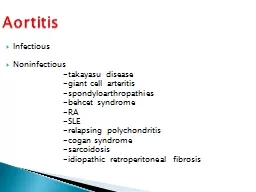/


takayasu disease giant cell arteritis spondyloarthropathies behcet syndrome RA ID: 775382
Download Presentation The PPT/PDF document " Aortitis Infectious Noninfectious" is the property of its rightful owner. Permission is granted to download and print the materials on this web site for personal, non-commercial use only, and to display it on your personal computer provided you do not modify the materials and that you retain all copyright notices contained in the materials. By downloading content from our website, you accept the terms of this agreement.
Slide1
Aortitis
Infectious
Noninfectious
-
takayasu
disease
-giant cell
arteritis
-
spondyloarthropathies
-
behcet
syndrome
-RA
-SLE
-relapsing
polychondritis
-
cogan
syndrome
-
sarcoidosis
-idiopathic retroperitoneal fibrosis
Slide2Takayasu
Arteritis
Slide3Aortic arch syndrome
Pulseless
disease
Slide4General consideration
Greatest frequency in Asian countries but distribution of disease is worldwide
Unknown etiology(auto immune mechanism?)
Women are affected about 10 times more often than men.
Median age of onset is 25 yrs
Slide5The
incidence of TA
is estimated to be 2 .6 per 1,000,000 persons in the United States and 1 .26 per 1,000,000 in northern Europe . Autopsy series from Japan point to a higher incidence, with 1 in every 3000 autopsies having a features of TA .
Slide6Granulomatous lesion similar to giant cell arteritis.Mononuclear cell infilteration macrophages lymphocyte ( T,gamma-delta,cytotoxic,natural killer) B lymphocyteCytokaines (IL-6,TNF)
pathogenesis
Slide7Histo pathology
Active stage
……..
granulomatous
arteritis
Late stage
…………. Medial
degeneration,fibrous
scaring,intimal
proliferation,thrombosis
Slide8Slide9Slide10Aneurysm
formation is less common than
stenosis
(3-4 times)
An important cause of death is
aneurysm
rupture
Left
sub
clavian
artery involvement….
90%
Thoracic aortic
lesion…..
66%
Abdominal aorta……..
50%
Aortoiliac
…….
12%
Pulmonary
arteritis
………
50%
Slide11Symptoms ,signs,lab tests
Pre
pulseless
phase (active )
fever
night sweat
malaise
nausea ,vomiting
weight loss
rash
arthralgia
Raynaud
phenomenon
splenomegaly
acceleration of ESR
elevated CRP
anemia
plasma protein abnormalities
Slide12Hypertension
is most often due to renal artery
stenosis
but can also be associated with suprarenal aortic
stenosis
or a chronically damaged, rigid aorta
Slide13Chronic phase
Upper
exteritities
claudication
Stroke
TIA
Dizziness
Syncope
Retinopathy
HTN….. ›50%
Angina pectoris
MI
HF
Pericarditis
(infrequent)
Intermittent
claudicasion
of lower limb
Slide14prognosis
Ischemic event or
Deth
over 5 yr……
25-30%
HTN ,cardiac involvement are associated with shortened life expectancy.
Slide15Major criteria 1- onset of illness‹ 40 yr 2- upper exterimity claudication 3- diminished brachial pulse 4- ›10 mmhg difference systolic BP in the arms 5 -Subclavian or aortic bruit 6- narrowing of the aorta or major branchesPresence of three criteria ……..high diagnostic accuracy
Diagnosis
Slide16Active phase………….corticosteroid and immunosuppressive therapy,cytotoxic agentsArterial stenosis ,obstruction……surgical operation,angioplasty and stenting
Management